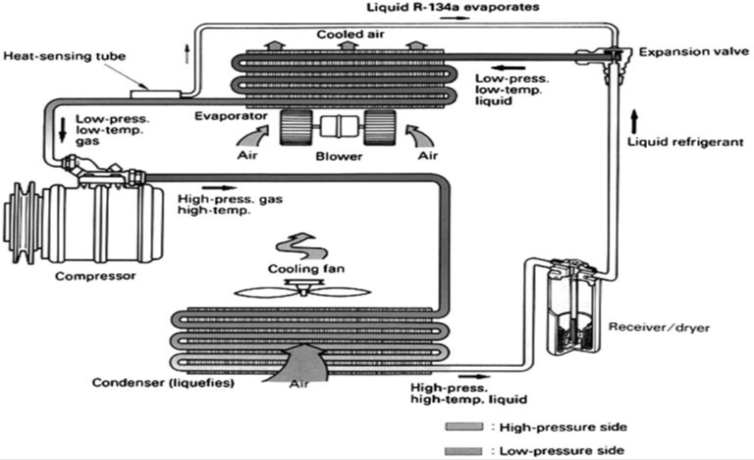SKEDSOFT
Introduction:
The air-conditioning system works on a continuous cycle. The heat comes from either inside (recycled air) or outside (fresh intake of air) the vehicle and is blown over the evaporator’s surface. Temperatures are approximate and are dependent on refrigerant type, system load, and pressure and temperature relationship.
Air-Conditioning Cycle:

- The refrigerant flows into the condenser. The condenser has numerous cooling fins in which the vapour is pumped. In the condenser the high pressure vapour condenses into a high pressure liquid.
- This is achieved by reducing the temperature from, for example, 80°C to below 57°C which is the refrigerant’s boiling point.
- This is achieved by forcing air over the surface of the condenser enabling heat to transfer from the refrigerant to the outside air thus reducing its temperature (subcooled). Only refrigerant in the form of a high pressure subcooled liquid leaves the bottom of the condenser outlet.
- The subcooled liquid refrigerant flows into the receiver drier which stores, dries and filters the liquid refrigerant. The subcooled liquid refrigerant then flows from the receiver drier to the expansion valve which then changes the refrigerant into low pressure, low temperature liquid/vapour.
- This is achieved by lowering the pressure using a variable orifice. The orifice has high pressure one side (from the receiver drier) and low pressure the other (evaporator and compressor) and allows a small quantity of refrigerant to flow through it.
- The sudden drop in pressure and temperature causes some of the refrigerant to vaporize which is called a flash gas. The low pressure low temperature liquid/vapour then flows to the evaporator where the heat is transferred from its surface to the refrigerant through vaporization.
- The heat comes from either inside (recycled air) or outside (fresh intake of air) the vehicle and is blown over the evaporator’s surface. Once the refrigerant has completely vaporized and reached its saturation point it should still be able to carry more heat.
- The refrigerant continues to flow through the remainder of the evaporator coils absorbing more heat and becoming slightly superheated. The low pressure low temperature slightly superheated vapour refrigerant flows to the compressor and the cycle repeats itself.